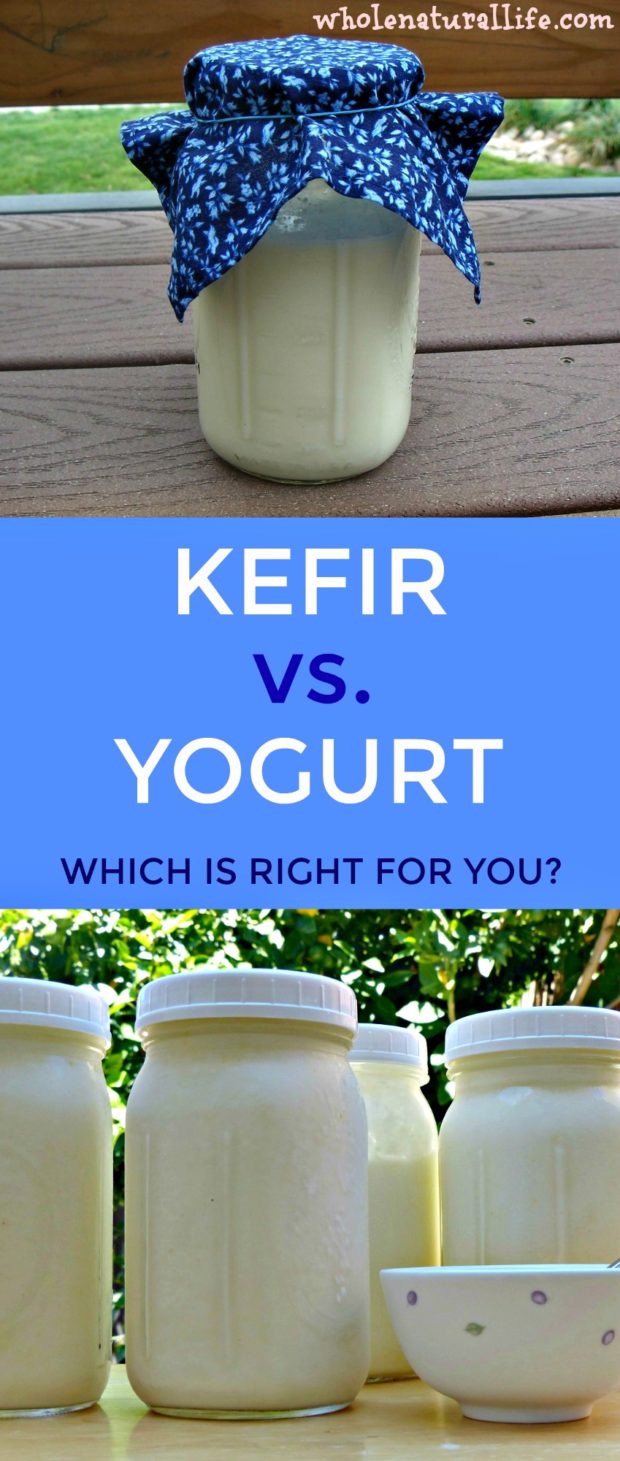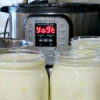
Do you want to add a fermented dairy product to your diet, but aren’t sure whether kefir or yogurt is the better option? Both of these dairy products have their own advantages and disadvantages, and either may be a better fit for you depending on your goals and current lifestyle. Read on as I breakdown the differences between kefir vs. yogurt.
Health Benefits of Kefir vs. Yogurt
Both kefir and yogurt contain probiotics that benefit your digestive health. Kefir contains a larger number and greater variety of probioitcs. It also contains several yeast strains that benefit your digestive system.
Taste of Kefir vs. Yogurt
Taste is pretty subjective, but still worth including here. 🙂
Most people are familiar with the sour taste of yogurt. Kefir is sour, too, but it also has a bit of a yeasty taste, due to its yeast content.
Some people love the taste of plain kefir. Personally I never really cared for it, and although I drank kefir for years, I always had to disguise the taste a bit by adding other flavors to it.
You can potentially change the taste of both kefir and yogurt by experimenting with how you culture each product.
Consistency of Kefir vs. Yogurt
Kefir is liquidy and is usually consumed as a beverage. Yogurt is usually thicker than kefir and is eaten with a spoon. You can make your yogurt thinner or thicker by trying out different yogurt cultures.
You can also make yogurt and kefir thicker by straining out some of the whey. (Greek yogurt, for instance, is yogurt that has had most of the whey removed.)
Making Kefir and Yogurt
Kefir and yogurt are made very differently. Kefir is made at room temperature using kefir grains, symbiotic colonies of yeast and bacteria that consume the lactose in milk. Most yogurt, on the other hand, is cultured at warmer temperatures, around 110 degrees, using a powdered yogurt starter or finished yogurt reserved from a previous batch. (Some yogurts can be cultured at room temperature, although you need to buy a special yogurt culture designed for this purpose.)
Kefir requires daily maintenance. In order for your kefir grains to remain healthy, you need to make a new batch of kefir every day. (If you go on vacation, or need to take a break from making kefir for some other reason, you can put your grains in the fridge for a few days, but you should only do this very occasionally.) As you become skilled at making kefir, you should be able to make a new batch in only five to ten minutes.
Unlike kefir, yogurt doesn’t require day to day maintenance. With yogurt, you make a larger batch at one time. If you’re trying to reuse a yogurt starter, you will need to make a new batch every week. If you buy a new powdered starter every time, you can make new yogurt only when you need it. (This is what I do, because I don’t want to worry about making a new batch every week.) Making a batch of yogurt takes several hours, depending on how long you are culturing your yogurt for, although hands-on time is short, maybe 10 or 15 minutes total.
Kefir and yogurt also require different supplies. Kefir requires kefir grains, two glass jars, and a strainer. Yogurt requires a yogurt starter, glass jars and some way of keeping your yogurt at 110 degrees while it’s culturing. I like to use my Instant Pot, but you can also use a dehydrator, a cooler, a crockpot, etc.
Bottom Line: Which is Right for You?
If your main goal is adding a therapeutic, probiotic-rich fermented food to your diet, I think kefir is the better choice. It contains a larger number and more variety of beneficial microbes than yogurt.
Making kefir does, however, require daily maintenance. If your life is not such that you can devote about 10 minutes to making a new batch of kefir at roughly the same time every day, kefir is not a good option for you.
If you’d rather make a batch of yogurt when you have time, I think yogurt is a better choice. That’s what I’m personally doing right now. I made kefir every day for years, but eventually things became too hectic, and right now I’m glad that I don’t have that extra responsibility every day. Yogurt may not have quite as many health benefits as kefir, but it’s still very good for you.
If you’re ready to dive in to either kefir or yogurt, be sure to check out my posts on how to make kefir and how to make Instant Pot yogurt!
What about you–do you prefer kefir or yogurt? Or both? 🙂
STANDARD FTC DISCLOSURE: In order for me to support my blogging activities, I may receive monetary compensation or other types of remuneration for my endorsement, recommendation, testimonial and/or link to any products or services from this blog. Please note, I only ever endorse products that are in alignment with Whole Natural Life’s ideals and I believe would be of value to my readers. Please also note that Whole Natural Life is a participant in the Amazon Services LLC Associates Program, an affiliate advertising program designed to provide a means for sites to earn advertising fees by advertising and linking to amazon.com.


